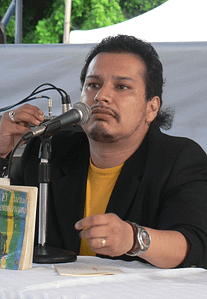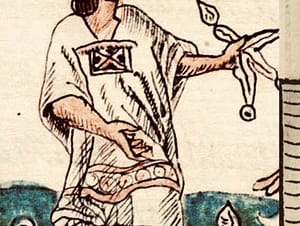
The novel consists of 53 fragments (or scenes). When naming, meaning is conferred and this is according to the image it projects. Its connotation gives the meaning, in this case, when naming it "witch" as part of the indictment, it is given a negative connotation. Especially when adding variables among which stood out, being a woman and being indigenous when their deficiencies were something perfectly natural.
Content
Witch, sorceress, woman ...?
If so many words were used to name it, why was «witch«?
- Maybe it took for title "guachichil witch"From the base article for the novel"Visions of a witch guachichil in 1599: towards an indigenous perspective on the conquest of San Luis Potosí ". [1]
- Maybe he used «guachichil witch! for being synonymous with sorceress, (in Spanish and Nahuatl). The clergy pointed to a witch as "the woman who had lost the fear of God, who felt free to lead a vicious and libidinous life ». Others gave the word «witch»To call a woman that way, old and ugly.
- Although, according to Myriam wigutov , artist, yoga instructor and witch says that "Witch, it comes from a beautiful and ancient Egyptian word and practice: 'Baq', it has several meanings: Feminine power, a woman who knows and uses power and its magic words. So, witch means "Empowered Woman". But… power? I wonder if it is something that the «bruja guachichil«, Central character in this work since in the end he suffered death. I ask myself again, is death a failure? Or just a step towards something else?
Witch, healer or herb?
Continuing with the reflection. In this 21st century some women call themselves witches, it is a form of active resistance. A way of rescuing the memory of those women who died, or who were killed, for being women calling them "Witches" to justify the crime.
To the "witch", he is described with the stereotype of the “witchBad and eats children, as in stories or Halloween parties: "In addition to being crippled, the Indian woman had dozens of warts that cross her battered neck, messy hair, eyes with white cataracts, hanging eyelids, like bags of meat, wrinkles, crow's feet, mean ..."
It is called old, almost at the end we find the reason: eIt was an old woman of +80 years, then, “he was born the year that Hernando de Cortés and his hosts arrived in Greater Tenochtitlán ”. (1,519). Sand knew and tolerated his role as "healer"Or"yerbera » because "It was good", they were saying, to take care of their «little brothers»The iIndigenous. Here is one more reflection to ask ourselves if said character currently exists under a «tolerance" Similary.
The Witch Guachichil
Some historical witches gained notoriety, such as the Salem Witches, the Witch of Évora, a fictional character who emerges in a city in Portugal, and Alice Kyteler (the 1st convicted witch in Ireland to escape), among many others.

Like all "witch"That he respects himself, he fulfills his role, there are prosecution witnesses but none useful for the defense,"not even his indigenous brothers whom he healed»Even Andrés, her ex-partner accused her. The "murder«, Or the heresy committed against the church, were in the background. It would be because at that time, the friars emphasized accusations about the sexual pleasures of women. Very little or never, the role of his or her partners was punished. A way to make invisible having been a promoter and guide for 150 indigenous people who rose up? Being a ringleader, leader or promoter were terms allowed only for men? Why or why cover up the character's leadership?
Witch hunters.
Andrés, former partner of the «Guachichil witch» and witness for the prosecution, the author tells us"He wonders in silence ... if at first it was love." The legal techniques, the process and the statements obtained seem to adhere to the instructions of the "Manual of the perfect witch hunter"https://www.greelane.com/es/humanidades/historia-y-cultura/malleus-maleficarum-witch-document-3530785/from the Middle Ages, which laid the groundwork for treating witchcraft as a dangerous and heretical practice of associating with the devil and therefore a great danger to society and the church.
Death as a penalty appeared in the minds of the judges, from the beginning. They sought to identify, lock up and above all, kill the "witch". The same as the Inquisition did, not Santa, because Santa had nothing. To the gallows for being a commoner, to the stake for sacrilege and heretic, although first "justify" based on interrogations and torture "Looking for the terror, that they never managed to make it appear in their eyes."
"... what white people call sin"
Obtain the confession of the «guachichil witch»And the witnesses, inquiring about heresy, sexual pleasures, eroticism of the body, sex, like the one on that day, when it was "The body burning with desire, of what white people call sin”. All this, to exhort repentance and show the whipping or battering for the Indian, in a kind of lesson.
The narrative overflows the reader's imagination. It allows to locate in time and space the San Luis of that time with a descriptive, concrete and precise language. He does not forget to visualize the power (of the Spanish invaders) and the submission (of the original indigenous peoples). He mentions the dispossession, which was concluded, thanks to the power of arms.
The Criminal Cause of the «guachichil witch«, Historical fact enriched with fiction: the penultimate year of the sixteenth century, the exact date: July 19, 1599.
Asymmetric power relations.
And the characters are revealed. Male, mostly, (prosecution witnesses, defender, a higher justice, the imaginary Miguel Caldera and Fray Diego de la Magdalena, etc.) These last two, thanks to the licenses to make fiction a possibility, were a success , enrich the text by giving it greater relevance with such characters involved. Reading with a gender perspective allows us to construct a critical vision of the stories of the dominant culture and the invisibility of women of that time, if not in the actions, if in the compilation of them. Highlighting it makes it possible to propose the creation of different views, of more incisive readings, capable of influencing the overcoming of patriarchal ideologies.
It is not only about analyzing asymmetric power relations. Also, to question the construction or absence of an equity approach. (example: whipping or beating for the Indians and death for the guachichil witch) The gender perspective and the critical analysis of discourse would make a reading possible that goes beyond the literary and literal meaning.
Delegitimize or legitimize inequalities.
The historical narrative, as in this case, could provide interpretations, in which the reader more easily recognizes asymmetric power relations. And as Almudena Hernando maintains, https://es.wikipedia.org/wiki/Almudena_Hernando (Spanish archaeologist and professor) inequalities are legitimized, teaching members of society to look at the world, through the particular gaze of those in power.
That "otherness"That women represent, is marked by inferiority in the face of an alleged"prestige»Of the male, by the symbolic disqualification and by the concrete oppression of a patriarchal society. Especially with representations and stereotypes, loaded with negative connotations. This affirms prejudices and unfavorable behaviors towards them.
" Non omnis moriar "
Events do not follow a timeline, there are gaps in time and space. They deviate from the main character, allowing others to stand out. This shape gives it a broader context, great richness and expressive creativity.
" Non omnis moriar ", One of the clues? at least. Since naming the poem by Manuel Gutiérrez Nájera, to find the line: I will not die at all, my friend! makes the reader a grateful co-author, who finds the deep meaning of this prose. Because the words in this publication are like coins, one is worth many. The text is lavish in metaphors, onomatopoeia, images, references ... and much more.
Secondary characters.
Characters could be listed, real or fictional. From Fray Antonio granados, to Don Gabriel, the greater justice, the neighbors, Narciso Garay de Vega and David de Cortés, to the vision with the Saints Miguelito Arcángel, Señor Santiago, San Isidro de las buena aguas and the burning of the Saucito.
Characters, such as Old Simeon, Andrew, a couple of the «Guachichil witch«, The clerk, the executioner, Fray Diego de la Magdalena, his murdered friend Fray Gregorio de San Miguel, Don Pedro de Arizmendi, the Creole Dalia Garmendia and her children, Ana the slave, initiator in occult arts and her son Seraphincillo, the Indigenous Sudor, Juan Sabás, Miguel Caldera, the Gualiname Indian, whose yellow brushstrokes on his face, whipped his ambition, that of the black shawl speaking from a distance, the incorrupt corpse of the Indian ... and many more if we add the 150 Indians summoned by the sorceress to take up arms, an event that gives the certainty of the leadership of this healer, sorceress or «witch".
Attacks in both directions.
The murder of Xavier de Ibarra and his family, as an example, allows us to imagine so many sad nights, rivers of blood, revenge, ambition and so many atrocities planned and fought in that New Spain world that was not only Spanish, against indigenous people. Interesting to think in both directions. Possible, even in fiction, when reading that Copuz the old man, attending to his counselor (absent, mysterious, the nameless one) gathers the chiefs of the Council to plan the defense of the Great Chichimeca.
They could not miss fragments about the worldview, the beginning of the world and their beliefs. Syncretism and the narrative voice takes us on an amazing journey. It is similar to the labyrinth in which at every moment, it seems that we find the common thread. Sometimes it is like that, in others, we continue to enjoy the poetic prose, phrases and words in Spanish, Latin, Nahuatl or Chichimeca.
Finally.
"...the woman is more powerful than the man ...”Said the sorceress Indian to Fray Diego de la Magdalena. When they hanged her, they decided not to give her a grave. They had to prevent them from locating her, or using her remains as an amulet, or worse still, that such an amulet had powers. Was it the ancestral and recurring fear, of the man to the woman? What did they do to avoid it? There are still questions to be answered, in each rereading we can find them.
When asked, who were the witches? and who were his executioners? It deserves a response with a gender perspective, with the lights pointing to the reasons and passions, written and hidden.
I like the author's openness, it allows me to broaden my optimism for future publications, as he says: “These are times to re-write history, to delve into readings and within ourselves, to build other ways of being, of being, of name us… ”It obviously reminded me of Rosario Castellanos and the final sentence of her poem:“ Another way of being human and free. Another way of being. "

email: srandrea@prodigy.net.mx
[1] [1] NOTE: “Criminal proceedings brought against a Guachichil Indian woman who promoted the uprising of the Indians on July 18, 1599, in Tlaxcalilla, Accused of sullying the faith of the Indians, persuading them not to attend mass, desecrating the churches and kill the Indian Agustín, who he put a straw in his ear ”.




